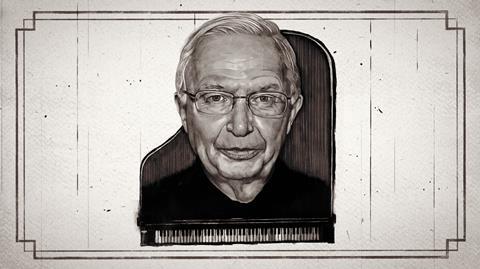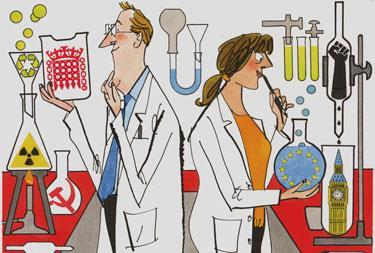The supramolecular innovator on the importance of different cultures in research, working like a pianist, and being shocked by an opera

Jean-Marie Lehn received the Nobel Prize in Chemistry in 1987 along with Donald Cram and Charles Pedersen for synthesising cryptands.
I had a very dedicated primary school teacher, I owe him a lot. He really pushed us to go into high school. He would spend hours of his off time setting us problems, having us solve them and then correcting them. My parents were very intelligent, but they didn’t have much training. My mother had more than my father. My father was a baker, pianist (in particular accompanying silent movies) and organist.
In high school, I followed the classics section, Greek and Latin, English and German and philosophy in the last year. After the baccalauréat, I joined the University of Strasbourg where I studied natural sciences. I also followed a course in optics, in part to prove to myself that I was able to also understand advanced physics.
I got my PhD in chemistry under the supervision of Guy Ourisson in 1963 on structural studies of natural products (triterpenes) by the then novel powerful NMR spectroscopy. Then during my postdoc at Harvard with R B Woodward, while participating in the total synthesis of Vitamin B12, I also took on the side a course in quantum mechanics, learned how to operate an IBM 1620 computer and performed some Extended Huckel computations with Roald Hoffmann.
Returning to the University of Strasbourg, I started my independent group in the area of physical organic chemistry pursuing various studies involving NMR. When Alain Veillard arrived in Strasbourg from IBM bringing along the IBMOL ab initio quantum chemistry program that did not have introduce preconceived parameters, I became convinced of the power of these methods. Thus, we studied ammonia, NH3, which inverts like an umbrella, and its corresponding phosphorus compound, phosphine, PH3. For the latter, the result of the computation was a pyramid with bond lengths 0.1 angstrom from the real ones, the bond angle a few minutes apart, and quite a good dipole moment.
There’s a story about two physicists from Poland who had calculated the distance between the two hydrogens in the hydrogen molecule to many decimals. The last decimals did not agree with the experiment. The theoreticians told the experimentalists: ‘You should redo your experiments.’ And they were right – which means that if you push the theory to its end, you get the right answer.
In parallel, we started the study of molecular cages giving the cryptate inclusion complexes with two graduate students, Bernard Dietrich and Jean-Pierre Sauvage. It led to the introduction of the notion of molecular recognition and then expanded into supramolecular chemistry and beyond.
My free time is mainly for music. I started learning to play the piano when I was six. When I’m at home, I play half an hour a day or more. For me, number one is Beethoven. He invented a totally new type of piano music. But I do not have enough time. I think science or music really can take up all your life. When people complain that they have to work so much in science, I say: look at a pianist, they don’t count their hours, they play a lot. It depends what you want to do with your life.
One evening, in Rome, having dinner with Victor Weisskopf, a former president of MIT, we started talking about music. And it turns out that we had the same three favourite operas: Wozzeck by Alban Berg, Tristan und Isolde by Richard Wagner and Don Giovanni by Mozart.
Wozzeck was a shock for me the first time I saw it, because it was totally different. Operas were supposed to be nice stories, have nice songs. This was an opera about a poor guy, a soldier, who was treated very badly. He had a woman, but he was not married, and they had a child, a little boy. She had a relationship with someone else, and in the end Wozzeck kills her and he drowns in a lake. So sad story, but so moving and perfect music.
Why not allow people to publish at least an abstract in their own language?
I would like to meet Emil Fisher who did fantastic work in his times with very few means. I think all chemists admire that, to have been able to do what he did, and others did at that time, with very few methods to control and analyse experiments. I don’t know exactly how he was as a person. Of course, scientists can have bad character, but they may still be very good scientists.
If there was one thing I would change about the way research is done, it would be something very simple: less pressure to publish in so-called high impact journals. Less pressure to publish a great number of papers. Of course, if you do something interesting that you want to publish, do it, but don’t be pushed to do it in certain journals because it’s considered better there.
The paper on cryptates that was at the origin of our studies on molecular recognition and eventually led to supramolecular chemistry was published in Tetrahedron Letters. In French. Jean-Pierre Sauvage, my former student who got the Nobel Prize in chemistry in 2016, also published his initial paper in French in Tet. Letters! He probably did it to take a stand. Using only one language in science makes life easier of course. But, when we, Peter Gölitz and myself, started Chemistry – A European Journal we were supported by the German Chemical Society. I said: Why not allow people to publish at least an abstract in their own language? So we had abstracts in Hebrew, in Basque, in Hungarian, in Chinese… it was just recognising that there are other cultures, other languages.
I think high-profile scientists, such as Nobel laureates, have a responsibility to speak out about topics that are quite political, like nuclear power or GMOs. But of course, we have to first take advice from people who are experts. Having an opinion is not sufficient. It’s also a problem with the media. Nobel laureates get a lot of attention, maybe rightly so. But there are many other scientists who also get high-level prizes. They may not be Nobel laureates just because there were four names on the list and you can only have three laureates!













No comments yet